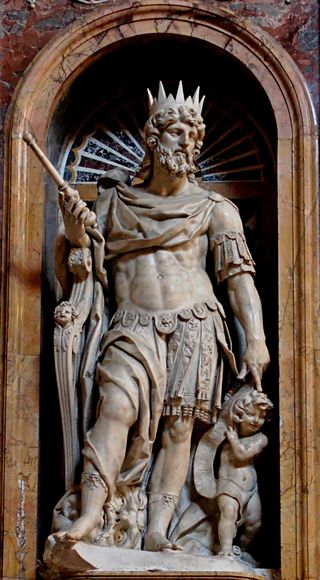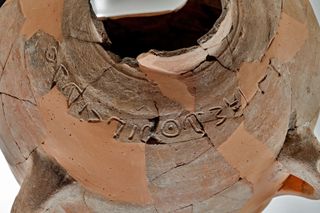Was King David Truly a Powerful King?

In the Hebrew Bible, King David is famous for slaying the Philistine giant Goliath and expanding Israel into a large kingdom centered in Jerusalem.
However, archaeological evidence for King David is limited, and there is an ongoing debate among archaeologists and other scholars about the size of David's kingdom and how many of the biblical stories are true.
When, exactly, he ruled is also uncertain. David's "reign is traditionally dated from about 1000 to 962 [B.C.]," wrote Daniel Bodi, a religious history professor at the Paris-Sorbonne University, in the book "Ancient Israel's History: An Introduction to Issues and Sources" (Baker Academic, 2014). However, the precise years of David's reign are uncertain and a subject of debate among scholars. [Photos: Rare Inscription from King David's Time]
From Goliath killer to ladies' man
David was the youngest son of a man named Jesse and was chosen by God to be king of Israel at a young age, the Hebrew Bible says. In David's early life, Israel was ruled by a king named Saul, and the country was often at war with a group called the Philistines.
David rose to prominence when, during a battle with the Philistines, he killed a powerful warrior named Goliath by hurling a sling stone at him.
"As the Philistine [Goliath] moved closer to attack him, David ran quickly toward the battle line to meet him. Reaching into his bag and taking out a stone, he slung it and struck the Philistine on the forehead. The stone sank into his forehead, and he fell facedown on the ground." 1 Samuel 17:48-49.
David rose in rank and power quickly after that, leading troops on order of King Saul and slaying numerous enemies, according to the Hebrew Bible. Eventually, Saul offered one of his daughters, Michal, for David to marry, and he accepted.
As David's fame increased, tension brewed between him and Saul and Saul feared that David would usurp his throne. While Saul's oldest son, Jonathan, was friends with David and attempted to convince his father that David was no threat, Saul eventually decided to kill David. But David escaped and took refuge with a Philistine king named Achish. David offered to fight against the Israelis for Achish but was refused because the other Philistine kings were uncomfortable with having David on their battle lines.
After Saul and several of his sons, including Jonathan, died while fighting a Philistine army, David came out of exile and tried to assert his kingship over Israel. For several years, David was based at Hebron, about 20 miles (32 kilometers) south of Jerusalem, where he battled survivors of the house of Saul in a civil war. David eventually won and became king of all of Israel, the Hebrew Bible says.
He then expanded Israel's territory, conquering several towns and cities, including Jerusalem — a city which he would later make his capital. As David's kingdom grew, he took on more wealth — and more wives and concubines.
"David appears as a man with one deep personality flaw: He was a 'ladies' man.'" wrote Bodi.
This eventually got David into trouble with God. David was on the rooftop of one of his palaces when he saw a beautiful lady named Bathsheba bathing. She was married to Uriah the Hittite, a soldier fighting in King David's army. This didn't deter David, and he sent messengers to get her and he impregnated her.
David arranged to have Uriah killed while the soldier was fighting a group called the Ammonites. The king wrote a letter to one of his commanders telling him to "put Uriah out in front where the fighting is fiercest. Then, withdraw from him so he will be struck down and die." 2 Samuel 11:14-15. After Uriah was killed, David took Bathsheba to be one of his wives.
God was furious with David and sent a prophet named Nathan to deliver David a message: "'The sword will never depart from your house, because you despised me and took the wife of Uriah the Hittite to be your own.'" 2 Samuel 12:10.
The remainder of David's rule was fraught with peril. David and Bathsheba's first child died. (But their second child, named Solomon, survived and later became king of Israel.) David also faced multiple rebellions, including one led by Absalom, one of David's sons. [Biblical Battles: 12 Ancient Wars Lifted from the Bible]
While David succeeded in stopping the rebellion, Absalom was killed in battle and David mourned his death. In David's final year of rule, fighting broke out over who would succeed him. To resolve the issue, David had to get up from his deathbed to announce that Solomon would be king.
Ultimately, the kingdom that David helped build broke apart. After Solomon's death, Israel split in two, with a northern kingdom that retained the name Israel and a southern kingdom, based in Jerusalem, that was called Judah, the Hebrew Bible says.

Archaeological evidence
The archaeological evidence for King David's existence is limited, and much of it is controversial. Perhaps the most important piece of evidence linked to King David is known as the Tel Dan stele, which is an ancient and broken inscribed stone discovered in 1993 and 1994. The inscription tells how the ruler of a kingdom named Aram Damascus defeated a king of Israel named Joram and a king of Judah named Ahaziyahu, who were both members of the house of David.
The reference to "house of David" indicates that King David likely existed, wrote Eric Cline, a professor of classics, anthropology and history at George Washington University, in his book "Biblical Archaeology: A Very Short Introduction" (Oxford University Press, 2009).
"At a single blow, the finding of this inscription brought an end to the debate and settled the question of whether David was an actual historical person," Cline wrote.
Unfortunately, there isn't any other evidence of either David or his son Solomon. Another 2,800-year-old inscription called the Mesha stele (named after King Mesha of Moab, the person who erected it) has writing on it that some scholars believe refers to King David, but that's also heavily debated.
How powerful was David's kingdom?
There's even more debate among scholars over how powerful David's kingdom was, what territory it controlled and whether David's kingdom was ever the "united monarchy" that is supposed to have united the Jews.
Israel Finkelstein, an archaeology professor at Tel Aviv University, has argued that David's kingdom was more modest than what the Hebrew Bible claims.
"Over a century of archaeological explorations in Jerusalem — the capital of the glamorous biblical United Monarchy — failed to reveal evidence for any meaningful 10th-century building activity," Finkelstein wrote in the book "One God — One Cult — One Nation: Archaeological and Biblical Perspectives" (de Gruyter, 2010). "10th-century Jerusalem was no more than a small, remote highlands village, not the exquisitely decked-out capital of a great empire."
But some scholars disagree with Finkelstein's assessment. An archaeological team led by Eilat Mazar, a research fellow at the Hebrew University of Jerusalem's Institute of Archaeology, found a wall that the researchers believe dates to the 10th century B.C. and may have been built during the reign of King Solomon, David's successor. Mazar has also been investigating the remains of a large structure in Jerusalem that she thinks may be a palace built for King David.
Some archaeologists contend that there is strong evidence for King David's kingdom outside of Jerusalem. Recently, a team of archaeologists has been excavating a large site called Khirbet Qeiyafa. Radiocarbon dating indicates that human activity flourished in the site around 3,000 years ago.
Archaeologists at Khirbet Qeiyafa, led by Hebrew University of Jerusalem archaeology professor Yosef Garfinkel, have found the remains of large buildings including a royal palace that they believe King David used. However, their interpretation is controversial. While a few inscriptions have been found at Khirbet Qeiyafa, none mention King David, and it's debatable whether King David ever controlled the site.
Other recently discovered archaeological remains that King David may have controlled include a sophisticated gatehouse at a 3,000-year-old mining camp in the Timna Valley of southern Israel and a large, 3,000-year-old house at a site called Tel 'Eton, located southwest of Jerusalem. But again, no inscriptions describe who controlled those sites, and it remains unclear if King David had anything to do with them.
Additional resources:
- Read about recent research into the age of the Bible.
- Discover what Biblical Archaeology is.
- Learn about seven biblical sites that have been ravaged by looters.
Sign up for the Live Science daily newsletter now
Get the world’s most fascinating discoveries delivered straight to your inbox.

Owen Jarus is a regular contributor to Live Science who writes about archaeology and humans' past. He has also written for The Independent (UK), The Canadian Press (CP) and The Associated Press (AP), among others. Owen has a bachelor of arts degree from the University of Toronto and a journalism degree from Ryerson University.
